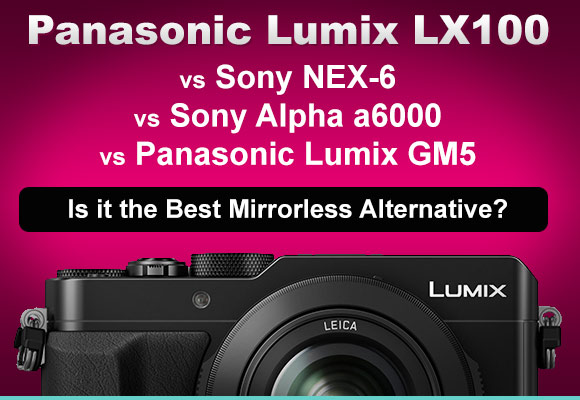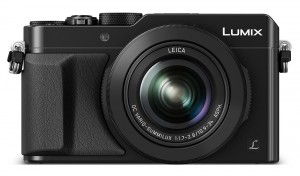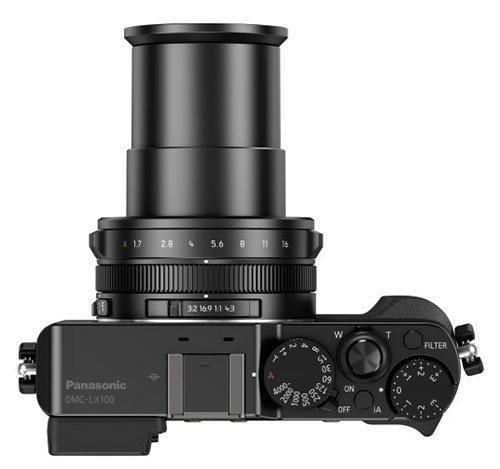
In this article I will compare the Panasonic Lumix LX100 fixed-lens large-sensor compact versus three popular mirrorless cameras: Sony NEX-6, Sony a6000 and Panasonic GM5. The LX100 will be in my opinion, one of the best-selling large-sensor compacts in 2014/2015. It’s certainly is an alternative to a mirrorless camera for people who don’t want to mass with interchangeable lenses, and still want a high-performing camera that is small in size.
This article focuses on the Panasonic Lumix LX100 and how how the other cameras compared to it. Therefore we’ll start with an introduction to the Panasonic LX100 and continue to the comparison after that.
Panasonic LX100
 Panasonic makes great cameras, whether CSC, bridge or compact, I trust the company to innovate and move forward in each camera iteration. With the Panasonic Lumix DMC-LX100 is seems that Panasonic is going all the way, introducing a premium large-sensor compact camera that can satisfy the demands of enthusiast and pros, searching for a second camera to carry around.
Panasonic makes great cameras, whether CSC, bridge or compact, I trust the company to innovate and move forward in each camera iteration. With the Panasonic Lumix DMC-LX100 is seems that Panasonic is going all the way, introducing a premium large-sensor compact camera that can satisfy the demands of enthusiast and pros, searching for a second camera to carry around.
Let’s start buy saying that the LX100 is not a compact system camera, as it doesn’t have the option to change lenses. It comes with a high-quality fixed lens instead. Just by looking at the camera design we can see that we are dealing with an advanced photographic equipment that has Panasonic signature on it. The LX100 has a metal body, small hand-grip on the right side and lots of buttons and dials. Those buttons and dials, as well as the lens rings (I’ll soon talk about those) give you fast access to frequently used camera settings as well as some buttons that can be customized for a specific setting of your choice (there are three Fn function buttons available at the back of the camera). This is an important feature that derived from DSLR cameras and are in high-demand by advanced photographers.
If you are a novice photographer, don’t be alert. Panasonic knows how to make their cameras easy to operate regardless of the number of buttons on the camera. You can shoot completely in auto mode and get excellent results as well.
OK, let’s go to business. One of the most important part of any camera is the sensor. Panasonic equipped the LX100 with a 12.8-megapixel Micro 4/3″ (Micro Four Thirds) MOS sensor. This is the same type of sensor found in Panasonic’s Micro Four Thirds Compact System Cameras. This type of sensor has shown to give an excellent balance between image quality and camera and lens size compactness. OF course with the LX100 you don’t need to worry about that, because you changing lenses is not an option. You should appreciate that this camera does features such a large sensor, which is not obvious (take a look at the sensor size comparison illustration below).

As you can see from the above illustration, the Micro Four Thirds sensor is significantly larger than the 1-inch sensor type you can find in the Sony RX100 III for example but less than APS-C which can be found in many DSLR and Compact System Cameras. Most compact cameras utilize a 1/2.3″ or 1/1.7″ sensor, but these are much smaller than the 4/3″, even much smaller than the 1″ one.
A larger sensor obviously imply higher dynamic range, low image noise (better low-light performance) and more prominent blurry background effect. So in short, the larger the sensor the better. Of almost all cases, the larger the sensor, the larger the camera and its optics (it’s also depends whether the camera has mirror and the lens optical design). The good news that although the LX100 uses a large sensor, the camera size is relatively very small. Can I put the LX100 in my pocket? — well, no. If you want a pocketable camera, you probably be looking at the RX100 III, but I think that this camera might worth that price, so continue reading to find our more about the LX100.
What does an interchangeable lens camera give you that a camera with a fixed lens does not? — Having the option to change lenses allows you to use special lenses that result in more flexibility of getting unique results, which you won’t be able to achieve with a fixed lens. It depends on the lens of course, but some photographers don’t want to be limited by the attached lens. For example, with a mirrorless camera you can buy a 1:1 macro lens, ultra wide-angle lens, super telephoto lens, super-fast prime lens, with those lenses giving you the option to expand the creative possibilities. For general photography, a fixed lens camera can be all that you’ll ever need. See how millions of people enjoy shooting with their mobile phone cameras, and this cameras has the most limited lens, a fixed focal length (prime) lens (some cameras do have an optical zoom lens, or advanced digital zoom option).
LX100 Lens Specs
The Panasonic Lumix LX100 features a Leica DC Vario-Summilux 24-75mm (35mm equivalent) F1.7-2.8 3.1x optical zoom lens. In terms of focal length, indeed, it’s quite limited, but as I said, as a general purpose camera or for street photography, it’s an excellent choice. In fact, this focal length is widely used by professionals due to its versatility (both wide and slightly tele).
In terms of exposure, the lens will give you the same F1.7-2.8 that you get with a full frame camera, it doesn’t change with the sensor size. F1.7-2.8 aperture range means that you can shoot at a maximum aperture of f/1.7 at the widest angle, which is very fast (the hole is widely open, allowing high amount of light to pass through), and it gets slower a bit as you zoom in, but f/2.8 for the tele-end is still very fast. This means that this lens and the camera itself is optimized for superb low-light performance. The difference between f/1.7 and f/2.8 is 1.4398 stops to be exact. So F1.7 aperture allows roughly 1.5 times more light to pass through the lens compared to F2.8. If you want to enjoy the best low-light performance, you should shoot with the widest angle (focal length: 24mm; aperture: F1.7). Oh, if you are confused here, note that the smaller the f-number (e.g. f/1.7), the larger the lens pupil is, and more light that can pass through to the sensor. So it’s the opposite of what the logic implies at the first time to hear about f-number term.

The LX100 lens extended as you zoom in and retracts back to the lens compartment as you zoom out. The lens has two rings: one for changing the aperture and the second for manual focusing (aka manual focus ring). This makes it easy to change those two while you eyes are on the subjects, whether via the electronic viewfinder or the rear display. It’s much easier to manual focus using a ring that do it using a touchscreen, therefore the LX100 will be favorable among those who shoot with manual focus for stills and/or video recording. Speaking about manual focusing, the LX100 comes with Focus Peaking, Manual Focus Assist and Pin Point AF, that helps with getting the subject in focus for a super sharp image (see the demo video below by Panasonic)
http://www.youtube.com/watch?v=mqmju3BKONU
This is a superb lens, and one of the main advantages that the LX100 has over its competitors.
Until now everything looks very tempting isn’t it, but we are not done yet, far from it 🙂
Looking at the back of the camera you’ll find a fixed 3.0″ 921K-dots LCD (not touchscreen). It has an Anti-reflective (AR) coating which is nice, but it’s unfortunate that it’s not tiltable nor touch-sensitive. That said, I think that for the targets audience, this is far from being a deal-breaker. I assume that most enthusiast couldn’t care less about the touchscreen, and I assume that they can leave without a tiltable display. I think that the reason Panasonic has chosen a fixed display is to keep the size to minimum. If you buy this camera you find yourself shooting mainly with the superb 2764K-dots Live View Finder I assume. This is a very high-res EVF and quite a larger one indeed (0.7x equilvalent). I also assume that novice photographers might find those two features useful (touchscreen and a swivel display), but hey, this camera is not aimed for them, most probably.
Among the other LX100 features are:
- 4K Ultra HD 30 fps video recording with stereo sound
- Light Speed AF (fast autofocus system) with DFD technology
- WiFi / NFC wirless connectivity (Easy sharing and backup of images and videos)
- Extract 8MP stills from 4K videos
- AF assist lamp
- Multi-aspect RAW shooting
- 22 creative filters
- Panorama mode
- Intelligent Auto mode (for beginners)
- In-camera photo editing/adjustments
- In-camera Red-eye correction
- Bundled Flash (the LX100 lacks a built-in pop-up flash)
- SD card comparability
- 350 shots battery life
- 11 fps burst shooting
- Stop motion animation mode
- Time lapse shot
- In-camera Raw development
- Highlight / Shadow control
- Level Gauge
- 1/16,000 shutter speed (using the electronic shutter)
And more..
You can see why it’s not hard to fall in love with this little camera. An excellent camera for both stills and video recording. I think for 4K recording it’s crucial to have a large sensor and large pixels for both better low-light performance and shallow depth of field effect. A tiltable screen is missing here, and I’m sure videographers would have wanted to have this. I think that for a camera ‘fast’ as this, a built-in flash isn’t that necessary at all, but I’m I sometimes find it useful as a filling flash, but I can certainly live without it.
An amazing package of features for a relatively good price. It’s not cheap, and for around $900 you probably could get a DSLR with two or even three lenses. That said, if you are looking into buying this camera, you probably not quite sure that you want to buy an interchangeable lens camera — well… unless there are advantages that will convince you otherwise. This why I wrote this article, and in the next section we’ll see whether the Sony NEX-6, Sony Alpha a6000 or the Panasonic Lumix GM5 can convince you to go mirrorless (or not). According to the best seller list on Amazon.com, it seems that many people were convinced, as it captured the #1 spot as the Best Seller in the Compact System Camera category (although it’s not a CSC camera, and I’m not sure why it was assigned to that category.. but never mind that — it’s very popular even before it was released, which say something about it — I assume).
I also think that the combination of the sensor-lens is much smaller to a comparable interchangeable lens camera, and also much cheaper!
LX100 vs NEX-6 vs a6000 vs GM5
Now lets dive into the most interesting part, the comparison. In this section I’ll compare the Panasonic Lumix DMC-LX100 versus the Sony NEX-6, Sony Alpha a6000 and Panasonic Lumix DMC-GM5. You’ll get to fully understand that key differences between those four cameras and their cons and pros. Before jumping on the LX100 blindly and with great enthusiasm, you should understand how the LX100 differs from its competition. You might be convince to buy one of the other camera models instead once you fully understand those key differences. OK, let’s dive straight in!
[table id=175 /]
Conclusion
As you can see from the above comparison table, the LX100 certainly looks very attractive camera. It doesn’t have the highest resolution, but this gives it an advantage in low-light (which I assume many of you care about). The built-in lens is amazing, a Leica lens with advanced optical design, super fast aperture across the focal length range and good macro capability.
The main question that you probably should ask yourself is whether or not you want or need to change lenses. If you do, the LX100 is probably not the camera for you. If you don’t you might have a winner here, but not only for that reason alone. The LX100 doesn’t have a Hybrid AF system like the Sony NEX-6 and a6000, but it utilizes a DFD technology that make its contrast-detect AF perform much faster for both stills and videos, and if it works for the GH4, it should be a stellar performer on the LX100 as well.
The LX100 is also am amazing camera for those who need lots of manual controls, fast access to frequently used camera setting and manual focusing. It’s built by design to satisfy the demands of enthusiast and professionals alike. The aperture ring and manual focus ring are a great surprise, and I am sure many of you will find it useful in the field. The viewfinder large and has high-res, although not as large as the Sony NEX-6, it’s still a very good one. The LX100 lacks built-in ND filter, but the super fast shutter speed covers for that.
The 4K video recording is a great option to have, but even if you don’t intend to shoot at 4K, you have plenty of frame rate for Full HD to choose from. I personally would have liked to have an articulating screen when shooting videos, something that you find in the Sony a6000 and NEX-6. If you care for a touchscreen, only the GM5 has it, but I don’t think that in any way that your buying decision should be based on this, although many of use already familiar with touch operation from our mobile phones and tablet devices.
So it looks like the Panasonic Lumix LX100 stacks pretty well against those other three mirrorless cameras, and can certainly be an excellent alternative to any of those cameras. I think that the LX100 is great for people who would otherwise would have bought a mirrorless with a maximum of two lenses: a normal zoom lens and a fast prime lens. The LX100 gives you a good normal to slightly tele zoom range with very fast aperture, so it’s close as it gets to the two-lens combo that I’ve described.
I think the size of the LX100 is just right with a good grip, good build quality, excellent button layout and classic design. Yes, this camera is small, but it shouts professionalism no matter how you look at it, both from the outside and inside. Yes, it has its cons like any other camera, and I know that sometimes it can be very limiting that you don’t have the option to change lenses. But I think that amateurs, enthusiast and the family and street photographers will fall in love with this camera and find it to be the perfect tool to capture those gorgeous memories.
Of course it’s not of Panasonic’s interest to convince you to ditch your Micro Four Thirds camera, and I’m sure that Panasonic did its homework and find a large audience that waits for a camera like this. Large-sensor compacts are probably what’s left from the conventional point-and-shoot market that was occupied by mobile phone cameras. If you want high-quality images and videos, don’t mind or you don’t need the option to change lenses (think about those amazing fast primes, would you miss them?), have the option to capture photos with very blurred background effect, have less noise in high ISO, have lots of manual controls and be more creative with your camera, the LX100 is the camera to go for – Simple as that.
By the way, because I haven’t mentioned that, the LX100 comes in either Silver or Black.